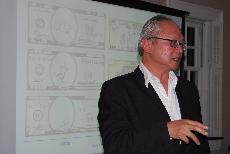“Mel Chin makes art that makes a difference in the world,” said Kathryn Shields, assistant professor of art, in her introduction to Chin’s lecture in Founders Gallery on Sept. 18.Chin began his talk by unhooking the microphone from the stand and singing Elvis Presley until a student stood up and threw a banana at him.
“The thing that was so cool was you actually got to see a great artist do performance art,” said assistant professor of art David Newton.
Chin then showed slides of his work, starting with replicas of White House columns that he made using materials symbolizing the Reagan administration’s complicity in the devastation and horror wrought on Latin America by the United Fruit Company.
Human suffering and tragic events, such as King Leopold II’s genocide of the people of the Belgian Congo and the first female suicide bomber in Israel, have provided inspiration for Chin’s work. In his lecture, Chin explained how the same was true for his current undertaking, The Fundred Dollar Bill Project.
When Hurricane Katrina threw the spotlight onto New Orleans, it was announced in the wake of its destruction that lead levels in the city’s soil were dangerously high. Some neighborhoods had as much as 2000 parts/million-five times the maximum “safe” amount of 400 parts/million.
Although it was initially thought that the hurricane deposited the lead, the Environmental Protection Agency said it had been there long before the storm hit.
As a result, 30 percent of children in the city have blood poisoning.
Chin’s Fundred Dollar Bill Project aims to treat the source of the problem. During his informal discussion in Hege-Cox Hall on Sept. 19, Chin expanded on how Fundred plans to do so. The project asks elementary through high school age students to make hundred dollar bills-he hopes to produce 300 million.
The project is open to people of all ages, although Chin emphasized the importance of getting the younger generation active and involved.
“I look at a sea of young people like you and it gives me hope for the sea of destruction,” said Chin as he encouraged Guilford students and faculty to make their own Fundreds.
Once Fundred have enough bills, they are going to drive a renovated armored car around the country to pick them up and deliver the “money” to Washington, D.C.
“We’re going to ask for an even exchange of 300 million big ones,” said Chin. “We need the voices of those most dramatically affected by lead on paper. Kids can’t vote, but they can draw.”
Senior Sam Sklover thinks that the project has enormous potential. “I believe it will be successful,” said Sklover. “I do not believe that any politician is heartless enough to veto 300 million children saying that New Orleans should be cleaned.”
With the money from Congress, Chin will begin the second part of the project, known as Paydirt. To neutralize the lead in the soil, Paydirt will mix it with ground up fishbone, which contains phosphate.
“Phosphate loves lead,” said Chin. “It’s like this chemical sex that occurs.”
The phosphate in the fishbone binds with the lead and keeps it from remaining and doing damage in the human body. Once the soil is treated, they will cover it with six inches of dirt dredged from the mouth of the Mississippi River.
Chin believes that fixing the soil is the first step to rebuilding New Orleans. “If you build on top of soil that is this polluted, there’s no game because your children will be poisoned,” said Chin.
Chin envisions Fundred and Paydirt as a blueprint for the cleanup of other cities with high lead contamination.
“I like that this is a pilot project,” said Newton. “I can imagine it generating interest in toxic soil sites all over the country, all over the world. He’s the kind of guy who could make that happen.

